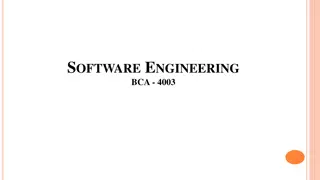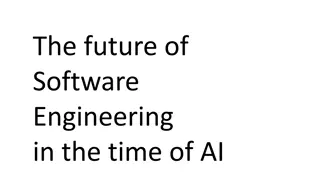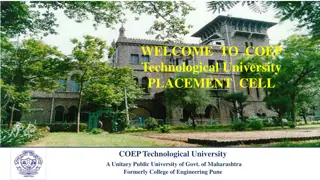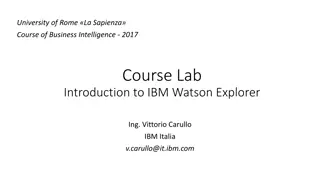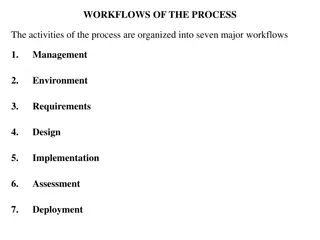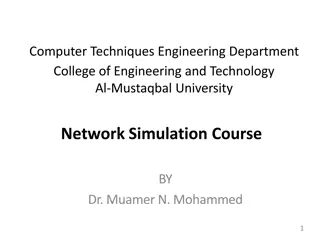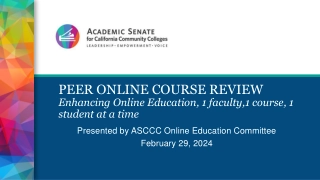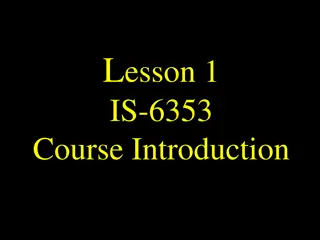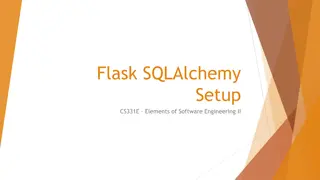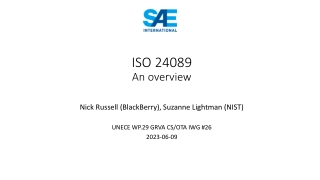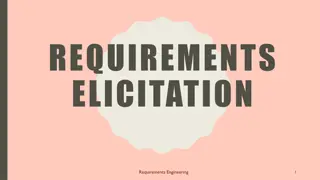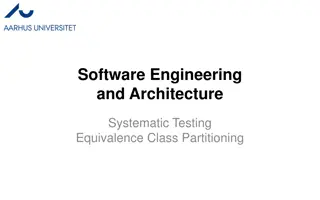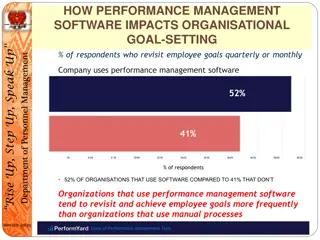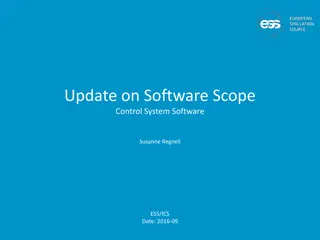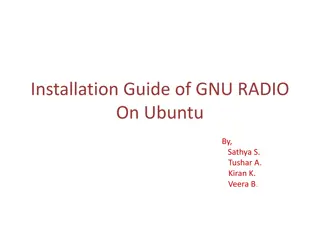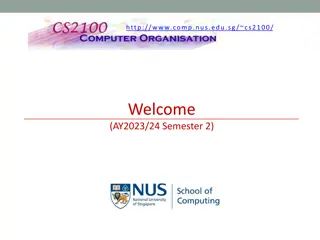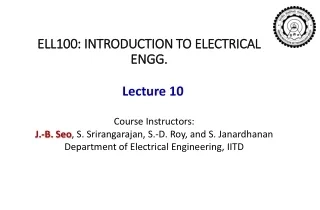Introduction to Software Engineering Course at National Taipei University
Explore the world of software engineering with Min-Yuh Day, Ph.D., at National Taipei University in this intensive course covering fundamental concepts, research issues, and hands-on practices. Topics include software products, Agile methods, cloud computing, security, testing, DevOps, and more.
Download Presentation
Please find below an Image/Link to download the presentation.
The content on the website is provided AS IS for your information and personal use only. It may not be sold, licensed, or shared on other websites without obtaining consent from the author. Download presentation by click this link. If you encounter any issues during the download, it is possible that the publisher has removed the file from their server.
Presentation Transcript
Software Engineering Introduction to Software Engineering 1122SE01 MBA, IM, NTPU (M5010) (Spring 2024) Wed 2, 3, 4 (9:10-12:00) (B3F17) Min-Yuh Day, Ph.D, Associate Professor https://meet.google.com/ ish-gzmy-pmo Institute of Information Management, National Taipei University https://web.ntpu.edu.tw/~myday 1 2024-02-21
Min-Yuh Day, Ph.D. Associate Professor, Information Management, NTPU Visiting Scholar, IIS, Academia Sinica Ph.D., Information Management, NTU Director, Intelligent Financial Innovation Technology, IFIT Lab, IM, NTPU Associate Director, Fintech and Green Finance Center, NTPU Artificial Intelligence, Financial Technology, Big Data Analytics, Data Mining and Text Mining, Electronic Commerce 2
Course Syllabus National Taipei University Academic Year 112, 2nd Semester (Spring 2024) Course Title: Software Engineering Instructor: Min-Yuh Day Course Class: MBA, IM, NTPU (3 Credits, Elective) GMBA in Finance; SHM; IPUG Details In-Person and Distance Learning EMI Course (3 Credits, Elective, One Semester) (M5010) Time & Place: Wed, 2, 3, 4, (9:10-12:00) (B3F17) Google Meet: https://meet.google.com/ish-gzmy-pmo https://meet.google.com/ ish-gzmy-pmo 3
Course Objectives 1. Understand the fundamental concepts and research issues of software engineering. 2. Equip with Hands-on practices of software engineering. 3. Conduct information systems research in the context of software engineering. 4
Course Outline This course introduces the fundamental concepts, research issues, and hands-on practices of software engineering. Topics include: 1. Introduction to Software Engineering 2. Software Products and Project Management: Software product management and prototyping 3. Agile Software Engineering: Agile methods, Scrum, and Extreme Programming 4. Features, Scenarios, and Stories 5. Software Architecture: Architectural design, System decomposition, and Distribution architecture 6. Cloud-Based Software: Virtualization and containers, Everything as a service, Software as a service 7. Cloud Computing and Cloud Software Architecture 8. Microservices Architecture, RESTful services, Service deployment 9. Security and Privacy; Reliable Programming 10. Testing: Functional testing, Test automation, Test-driven development, and Code reviews 11. DevOps and Code Management: Code management and DevOps automation 12. Case Study on Software Engineering 5
Core Competence Exploring new knowledge in information technology, system development and application 80 % Internet marketing planning ability 10 % Thesis writing and independent research skills 10 % 6
Four Fundamental Qualities Professionalism Creative thinking and Problem-solving 30 % Comprehensive Integration 30 % Interpersonal Relationship Communication and Coordination 10 % Teamwork 10 % Ethics Honesty and Integrity 5 % Self-Esteem and Self-reflection 5 % International Vision Caring for Diversity 5 % Interdisciplinary Vision 5 % 7
College Learning Goals Ethics/Corporate Social Responsibility Global Knowledge/Awareness Communication Analytical and Critical Thinking 8
Department Learning Goals Information Technologies and System Development Capabilities Internet Marketing Management Capabilities Research capabilities 9
Syllabus Week Date Subject/Topics 1 2024/02/21 Introduction to Software Engineering 2 2024/02/28 Peace Memorial Day (Day Off) 3 2024/03/06 Software Products and Project Management: Software product management and prototyping 4 2024/03/13 Agile Software Engineering: Agile methods, Scrum, and Extreme Programming 5 2024/03/20 Case Study on Software Engineering I 6 2024/03/27 Features, Scenarios, and Stories 7 2024/04/03 Make-up holiday for NTPU Sports Day (No Classes) 8 2024/04/10 Midterm Project Report 10
Syllabus Week Date Subject/Topics 9 2024/04/17 Software Architecture: Architectural design, System decomposition, and Distribution architecture 10 2024/04/24 Cloud-Based Software: Virtualization and containers, Everything as a service, Software as a service; Cloud Computing and Cloud Software Architecture 11 2024/05/01 Case Study on Software Engineering II 12 2024/05/08 Microservices Architecture, RESTful services, Service deployment 13 2024/05/15 Industry Practices of Software Engineering 11
Syllabus Week Date Subject/Topics 14 2024/05/22 Security and Privacy; Reliable Programming; Testing: Functional testing, Test automation, Test-driven development, and Code reviews; DevOps and Code Management: Code management and DevOps automation 15 2024/05/29 Final Project Report I 16 2024/06/05 Final Project Report II 12
Teaching Methods and Activities Lecture Discussion Practicum 13
Evaluation Methods Individual Presentation 60 % Group Presentation 10 % Case Report 10 % Class Participation 10 % Assignment 10 % 14
Required Texts Ian Sommerville (2019), Engineering Software Products: An Introduction to Modern Software Engineering, Pearson. 15
Reference Books Ian Sommerville (2015), Software Engineering, 10th Edition, Pearson. Titus Winters, Tom Manshreck, and Hyrum Wright (2020), Software Engineering at Google: Lessons Learned from Programming Over Time, O'Reilly Media. Project Management Institute (2017), Agile Practice Guide, PMI Project Management Institute (2021), A Guide to the Project Management Body of Knowledge (PMBOK Guide) Seventh Edition and The Standard for Project Management, PMI 16
Ian Sommerville (2019), Engineering Software Products: An Introduction to Modern Software Engineering, Pearson. 17 Source: https://www.amazon.com/Engineering-Software-Products-Ian-Sommerville/dp/013521064X
Ian Sommerville (2015), Software Engineering, 10th Edition, Pearson. 18 Source: https://www.amazon.com/Software-Engineering-10th-Ian-Sommerville/dp/0133943038
Titus Winters, Tom Manshreck, and Hyrum Wright (2020), Software Engineering at Google: Lessons Learned from Programming Over Time, O'Reilly Media. 19 Source: https://www.amazon.com/Software-Engineering-Google-Lessons-Programming/dp/1492082791
Project Management Institute (2017), Agile Practice Guide PMI 20 Source: https://www.amazon.com/Agile-Practice-Project-Management-Institute/dp/1628251999/
Project Management Institute (2021), A Guide to the Project Management Body of Knowledge (PMBOK Guide) Seventh Edition and The Standard for Project Management 21 Source: https://www.amazon.com/Guide-Project-Management-Knowledge-PMBOK%C2%AE/dp/1628256648
Software Engineering 22
Software Engineering and Project Management Design Test Deliver Build Analyze System and Software design Integration and system testing Operation and maintenance Implementation and unit testing Requirements definition Project Management 23
Information Management Management Information Systems (MIS) Information Systems 24
Information Management (MIS) Information Systems Organizations Technology Information Systems Management 25 Source: Kenneth C. Laudon & Jane P. Laudon (2014), Management Information Systems: Managing the Digital Firm, Thirteenth Edition, Pearson.
Fundamental MIS Concepts Business Challenges Management Information System Business Solutions Organization Technology 26 Source: Kenneth C. Laudon & Jane P. Laudon (2014), Management Information Systems: Managing the Digital Firm, Thirteenth Edition, Pearson.
Project-based software engineering CUSTOMER Problem generates helps-with implemented-by 1 Software Requirements CUSTOMER and DEVELOPER Source: Ian Sommerville (2019), Engineering Software Products: An Introduction to Modern Software Engineering, Pearson. DEVELOPER 27
Project-based software engineering The starting point for the software development is a set of software requirements that are owned by an external client and which set out what they want a software system to do to support their business processes. The software is developed by a software company (the contractor) who design and implement a system that delivers functionality to meet the requirements. The customer may change the requirements at any time in response to business changes (they usually do). The contractor must change the software to reflect these requirements changes. Custom software usually has a long-lifetime (10 years or more) and it must be supported over that lifetime. 28 Source: Ian Sommerville (2019), Engineering Software Products: An Introduction to Modern Software Engineering, Pearson.
Product software engineering DEVELOPER 1 Opportunity inspires realizes implemented-by Product features Software DEVELOPER DEVELOPER 29 Source: Ian Sommerville (2019), Engineering Software Products: An Introduction to Modern Software Engineering, Pearson.
Product software engineering The starting point for product development is a business opportunity that is identified by individuals or a company. They develop a software product to take advantage of this opportunity and sell this to customers. The company who identified the opportunity design and implement a set of software features that realize the opportunity and that will be useful to customers. The software development company are responsible for deciding on the development timescale, what features to include and when the product should change. Rapid delivery of software products is essential to capture the market for that type of product. 30 Source: Ian Sommerville (2019), Engineering Software Products: An Introduction to Modern Software Engineering, Pearson.
Software execution models Stand-alone execution Hybrid execution Software as a service User s computer User s computer User s computer User interface Product functionality User data User interface Partial functionality User data User interface (browser or app) Additional functionality User data backups Product updates Product functionality User data Product updates Vendor s servers Vendor s servers Vendor s servers Source: Ian Sommerville (2019), Engineering Software Products: An Introduction to Modern Software Engineering, Pearson.
Product management concerns Business needs Product manager Technology constraints Customer experience 32 Source: Ian Sommerville (2019), Engineering Software Products: An Introduction to Modern Software Engineering, Pearson.
Technical interactions of product managers Product vision management Product backlog management User stories and scenarios Product manager Acceptance testing Customer testing User interface design 33 Source: Ian Sommerville (2019), Engineering Software Products: An Introduction to Modern Software Engineering, Pearson.
Software Development Life Cycle (SDLC) The waterfall model Requirements definition System and Software design Implementation and unit testing Integration and system testing Operation and maintenance 34 Source: Ian Sommerville (2015), Software Engineering, 10th Edition, Pearson.
Plan-based and Agile development Plan-based development Requirements engineering Requirements specification Design and implementation Requirements change requests Agile development Requirements engineering Design and implementation 35 Source: Ian Sommerville (2015), Software Engineering, 10th Edition, Pearson.
The Continuum of Life Cycles High Incremental Agile Frequency of Delivery Predictive Iterative Low Low High Degree of Change 36 Source: Project Management Institute (2017), Agile Practice Guide, Project Management Institute
Predictive Life Cycle Analyze Design Build Test Deliver 37 Source: Project Management Institute (2017), Agile Practice Guide, Project Management Institute
Iterative Life Cycle Refine Prototype Analyze Design Build Test Analyze Deliver 38 Source: Project Management Institute (2017), Agile Practice Guide, Project Management Institute
A Life Cycle of Varying-Sized Increments Analyze Design Build Test Deliver Analyze Design Build Test Deliver Analyze Design Build Test Deliver 39 Source: Project Management Institute (2017), Agile Practice Guide, Project Management Institute
Iteration-Based and Flow-Based Agile Life Cycles Iteration-Based Agile Requirements Analysis Design Build Test Requirements Analysis Design Build Test Requirements Analysis Design Build Test Requirements Analysis Design Build Test Requirements Analysis Design Build Test Requirements Analysis Design Build Test Repeat as needed Flow-Based Agile Requirements Analysis Design Build Test the number of features in the WIP limit Requirements Analysis Design Build Test the number of features in the WIP limit Requirements Analysis Design Build Test the number of features in the WIP limit Requirements Analysis Design Build Test the number of features in the WIP limit Requirements Analysis Design Build Test the number of features in the WIP limit Repeat as needed 40 Source: Project Management Institute (2017), Agile Practice Guide, Project Management Institute
From personas to features 1 Personas A way of representing users inspire Natural language descriptions of a user interacting with a software product are-developed-into Scenarios 2 3 inspire Natural language descriptions of something that is needed or wanted by users Stories 4 Features define Fragments of product functionality 41 Source: Ian Sommerville (2019), Engineering Software Products: An Introduction to Modern Software Engineering, Pearson.
Multi-tier client-server architecture Client 1 Client 2 Web Server Application Server Database Server Client 3 Client 42 Source: Ian Sommerville (2019), Engineering Software Products: An Introduction to Modern Software Engineering, Pearson.
Service-oriented Architecture Client 1 S1 S2 Client 2 S3 Web Server Service gateway S4 Client 3 S5 S6 Client Services 43 Source: Ian Sommerville (2019), Engineering Software Products: An Introduction to Modern Software Engineering, Pearson.
VM Container Virtual web server Virtual mail server User 1 Container 1 User 2 Container 2 Server software Application software Application software Server software Guest OS Server software Server software Guest OS Hypervisor Container manager Host OS Host OS Server Hardware Server Hardware 44 Source: Ian Sommerville (2019), Engineering Software Products: An Introduction to Modern Software Engineering, Pearson.
Everything as a service Logistics management Software as a service (SaaS) Photo editing Database Software development Cloud Platform as a service (PaaS) management Monitoring Storage Network Infrastructure as a service (IaaS) Computing Virtualization Cloud data center 45 Source: Ian Sommerville (2019), Engineering Software Products: An Introduction to Modern Software Engineering, Pearson.
Software as a service Software customers Software provider Software services Cloud provider Cloud Infrastructure 46 Source: Ian Sommerville (2019), Engineering Software Products: An Introduction to Modern Software Engineering, Pearson.
Microservices architecture key design questions What are the microservices that make up the system? How should microservices communicate with each other? How should data be distributed and shared? Microservices architecture design How should the microservices in the system be coordinated? How should service failure be detected, reported and managed? 47 Source: Ian Sommerville (2019), Engineering Software Products: An Introduction to Modern Software Engineering, Pearson.
Types of security threat An attacker attempts to deny access to the system for legitimate users An attacker attempts to damage the system or its data Integrity threats Availability threats SOFTWARE PRODUCT PROGRAM Distributed denial of service (DDoS) attack Virus DATA Ransomware Data theft Confidentiality threats An attacker tries to gain access to private information held by the system 48 Source: Ian Sommerville (2019), Engineering Software Products: An Introduction to Modern Software Engineering, Pearson.
Software product quality attributes 1 2 Reliability Availability 7 3 Software product quality attributes Security Resilience 6 4 Usability 5 Maintainability Responsiveness 49 Source: Ian Sommerville (2019), Engineering Software Products: An Introduction to Modern Software Engineering, Pearson.
A refactoring process 1 2 Start Identify refactoring strategy Identify code smell 4 3 Make small improvement until strategy completed Run automated code tests 50 Source: Ian Sommerville (2019), Engineering Software Products: An Introduction to Modern Software Engineering, Pearson.



